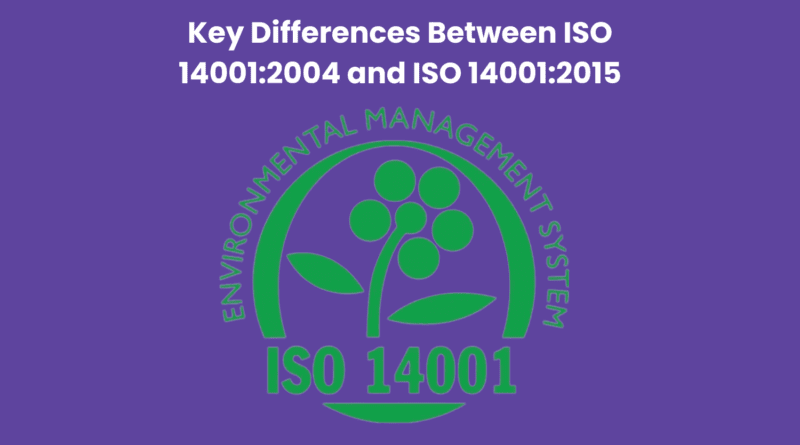Key Differences Between ISO 14001:2004 and ISO 14001:2015
ISO 14001 is a globally accepted standard in environmental management. It gives businesses a framework for recognising, evaluating, and controlling their environmental effects and continuously improving their performance. Professionals can get a better understanding of this standard using an ISO 14001 Certification.
Following its first publication in 1996, ISO 14001 has undergone many revisions. ISO 14001:2015, the most current edition, was released in 2015.
The previous version, ISO 14001:2004, was significantly revised into ISO 14001:2015. It modifies some current criteria and adds a number of new ones.
In this blog, we will go over the main distinctions in the context of ISO 14001:2004 vs ISO 14001:2015.
Key Differences between ISO 14001:2004 and ISO 14001:2015
Structure
Adopting the Annex SL structure was one of the biggest modifications to ISO 14001 in the 2015 edition. All ISO management system standards, including ISO 9001 (quality management) and ISO 45001 (occupational health and safety), have this structure.
Ten parts make up the Annex SL structure, and each one focuses on a different component of the management system. Thanks to this framework, organisations may link their environmental management system more easily with other management systems.
Leadership and Commitment
Environmental management requires the active participation and dedication of senior management, as emphasised by ISO 14001:2015. According to the guidelines, upper management must:
- Raise awareness of environmental issues inside the company.
- Set aside funds to maintain the environmental management system.
- Make sure that every business choice takes the environment into account.
- Regularly assess the organisation’s environmental performance.
Top management may contribute to developing an environmental responsibility culture throughout the company by showcasing their dedication to environmental management. This may result in numerous advantages, including better environmental performance, lower expenses, and increased brand perception.
Environmental Policy
Environmental policy is an essential part of any ISO 14001 environmental management system. It offers a framework for environmental decision-making and lays out the organisation’s environmental aims and objectives.
ISO 14001:2015 mandates that the environmental policy be more clearly defined and communicated to all employees.
Risk Assessment and Mitigation
Organisations must identify, evaluate, and reduce environmental hazards in accordance with ISO 14001:2015. It includes:
- Recognising possible environmental risks.
- Evaluating the probability and intensity of possible environmental effects.
- Putting policies in place to avoid or reduce harmful effects on the environment.
- Evaluating the success of risk-reduction strategies.
Organisations may lower their environmental liability, enhance their environmental performance, and get a competitive edge by managing environmental risks well.
Also Read Bitcoin Trading System Impacts on the Businesses of Costa Rica
Life Cycle Perspective
According to ISO 14001:2015, businesses must take into account how their goods and services will affect the environment at every step of their life cycle, from acquiring raw materials to reaching the end of their useful life. This involves taking into account the effects of:
- Extraction and processing of raw materials
- Production and manufacturing
- Distribution and transportation
- Usage and consumption
- End-of-life treatment and disposal
Organisations may lessen their total environmental footprint by considering the life cycle of their goods and services, which can help them recognise and solve any possible environmental problems early on.
Communication
ISO 14001:2015 highlights the significance of communicating environmental performance to interested parties concisely and accurately. This encompasses the community, clients, and staff. Effective communication may be achieved by organisations using a variety of techniques, including social media postings, website statements, sustainability reports, and annual reports. Through proficiently conveying their environmental performance, entities exhibit transparency and cultivate confidence among interested parties.
Continual Improvement
Organisations must continuously enhance their environmental performance in accordance with ISO 14001:2015. It includes:
- Setting goals and ambitions for the environment.
- Keeping an eye on and assessing environmental performance.
- Examining environmental data to find places that might need better.
- Putting preventative and remedial measures into practice.
- Evaluating the environmental management system’s efficacy.
Organisations may lessen their influence on the environment, increase the efficiency of their use of resources, and save money by consistently improving their environmental performance.
Benefits of ISO 14001 Certification
The ISO 14001 Certification has a lot to offer. Among the advantages are:
- Minimised impact on the environment.
- Enhanced environmental performance.
- Enhanced financial savings.
- Better recognition for the brand.
- A higher level of client happiness.
- Enhanced morale among staff.
- Improved compliance with environmental laws.
Conclusion
ISO 14001:2015 is an important update to ISO 14001:2004. It contains many additions to the current criteria and several new ones. By September 2018, organisations certified to ISO 14001:2004 must convert to ISO 14001:2015.
Thanks to this blog, the main distinctions between ISO 14001:2004 and ISO 14001:2015 should now be more evident to you.


